- Joined
- Oct 9, 2007
- Messages
- 47,453 (7.50/day)
- Location
- Hyderabad, India
| System Name | RBMK-1000 |
|---|---|
| Processor | AMD Ryzen 7 5700G |
| Motherboard | ASUS ROG Strix B450-E Gaming |
| Cooling | DeepCool Gammax L240 V2 |
| Memory | 2x 8GB G.Skill Sniper X |
| Video Card(s) | Palit GeForce RTX 2080 SUPER GameRock |
| Storage | Western Digital Black NVMe 512GB |
| Display(s) | BenQ 1440p 60 Hz 27-inch |
| Case | Corsair Carbide 100R |
| Audio Device(s) | ASUS SupremeFX S1220A |
| Power Supply | Cooler Master MWE Gold 650W |
| Mouse | ASUS ROG Strix Impact |
| Keyboard | Gamdias Hermes E2 |
| Software | Windows 11 Pro |
Intel silently enabled the product pages of several of its 7-series chipset-based LGA1155 motherboards, including three based on the Z77 Express. These include the Extreme Series DZ77GA-70K, Media Series DZ77BH-55K, and Media Series DZ77SL-50K. The DZ77GA-70K is a top-tier model that's built for built for heavily-overclocked gaming PCs. Intel paid due attention to areas such as a strong VRM, and a broad range of connectivity options. With power-delivery, we spy a 10+2 phase VRM backed by Intel's phase-shedding technology. Apart from four DDR3 DIMM slots, the LGA1155 socket is wired to two PCI-Express 3.0 x16 slots (x8/x8, when both are populated).
Other expansion slots on the DZ77GA-70K include one open-ended PCI-Express 2.0 x4, two PCI-Express 2.0 x1, and two legacy PCI. To ensure there are sufficient PCIe lanes for these slots, and the plethora of third-party onboard devices, Intel implemented a PLX PCI-Express bridge chip that increases the lane budget of the board. Storage connectivity includes four SATA 6 Gb/s (two from the PCH, two from third-party controller), four SATA 3 Gb/s, and one eSATA.
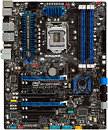
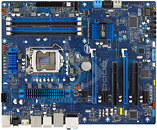
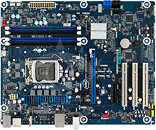
The DZ77GA-70K provides a total of eight USB 3.0 ports, four on the rear-panel, four via internal headers. 8-channel HD audio, two gigabit Ethernet interfaces, Firewire, and comeback-kid PS/2 mouse/keyboard combo connector (PS/2 keyboards have zero-NKRO by design, and can be dirt-cheap), complete the connectivity. The lone display output is an HDMI connector. Intel is working on a variant of this board, called DZ77RE-75K, which basically features Thunderbolt (that empty 15x15 mm chip spacer under the audio jack cluster, room for a "Cactus Ridge" L3510L controller).
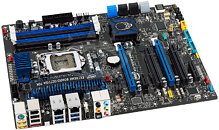
The Media Series DZ77BH-55K sees some love in the aesthetics department, with its blue anodized aluminum heatsinks, and heatsinks to the VRM to start with. This board uses a simpler 6+2 phase VRM to power the LGA1155 CPU. Expansion slots include two PCI-Express 3.0 x16 (x8/x8 with both populated), three PCI-Express 2.0 x1, and two legacy PCI. Storage connectivity includes four internal SATA 6 Gb/s ports (two from the PCH, two from a third-party controller), three SATA 3 Gb/s from the PCH, and one eSATA 3 Gb/s, wired to the PCH. This board has six USB 3.0 ports (four on the rear panel, two via header), one gigabit Ethernet interface, Firewire, 8-channel HD audio, and display outputs that include HDMI and DisplayPort.
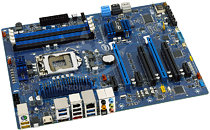
Lastly, there's the DZ77SL-50K, a value Z77 motherboard under the same Media Series. It has the same 6+2 phase VRM, but using more cost-effective components. Expansion slots include one each of PCI-Express 3.0 x16, open-ended PCI-Express 2.0 x4, PCI-Express 2.0 x1, and three legacy PCI. The PCH handles the entire SATA port budget, with two SATA 6 Gb/s, three SATA 3 Gb/s, and one eSATA 3 Gb/s. Display connectivity includes just the HDMI. The PCH also handles the USB 3.0 port budget entirely, with two ports on the rear panel, two via header. 6-channel HD audio and gigabit Ethernet make for the rest of it.
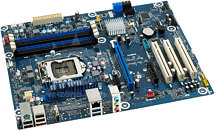
View at TechPowerUp Main Site
Other expansion slots on the DZ77GA-70K include one open-ended PCI-Express 2.0 x4, two PCI-Express 2.0 x1, and two legacy PCI. To ensure there are sufficient PCIe lanes for these slots, and the plethora of third-party onboard devices, Intel implemented a PLX PCI-Express bridge chip that increases the lane budget of the board. Storage connectivity includes four SATA 6 Gb/s (two from the PCH, two from third-party controller), four SATA 3 Gb/s, and one eSATA.



The DZ77GA-70K provides a total of eight USB 3.0 ports, four on the rear-panel, four via internal headers. 8-channel HD audio, two gigabit Ethernet interfaces, Firewire, and comeback-kid PS/2 mouse/keyboard combo connector (PS/2 keyboards have zero-NKRO by design, and can be dirt-cheap), complete the connectivity. The lone display output is an HDMI connector. Intel is working on a variant of this board, called DZ77RE-75K, which basically features Thunderbolt (that empty 15x15 mm chip spacer under the audio jack cluster, room for a "Cactus Ridge" L3510L controller).

The Media Series DZ77BH-55K sees some love in the aesthetics department, with its blue anodized aluminum heatsinks, and heatsinks to the VRM to start with. This board uses a simpler 6+2 phase VRM to power the LGA1155 CPU. Expansion slots include two PCI-Express 3.0 x16 (x8/x8 with both populated), three PCI-Express 2.0 x1, and two legacy PCI. Storage connectivity includes four internal SATA 6 Gb/s ports (two from the PCH, two from a third-party controller), three SATA 3 Gb/s from the PCH, and one eSATA 3 Gb/s, wired to the PCH. This board has six USB 3.0 ports (four on the rear panel, two via header), one gigabit Ethernet interface, Firewire, 8-channel HD audio, and display outputs that include HDMI and DisplayPort.

Lastly, there's the DZ77SL-50K, a value Z77 motherboard under the same Media Series. It has the same 6+2 phase VRM, but using more cost-effective components. Expansion slots include one each of PCI-Express 3.0 x16, open-ended PCI-Express 2.0 x4, PCI-Express 2.0 x1, and three legacy PCI. The PCH handles the entire SATA port budget, with two SATA 6 Gb/s, three SATA 3 Gb/s, and one eSATA 3 Gb/s. Display connectivity includes just the HDMI. The PCH also handles the USB 3.0 port budget entirely, with two ports on the rear panel, two via header. 6-channel HD audio and gigabit Ethernet make for the rest of it.

View at TechPowerUp Main Site




